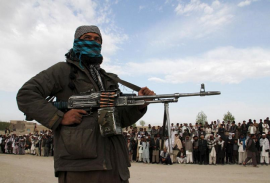
The US has not only failed in eliminating terrorism from Afghanistan but also has been unable to eradicate opium production, rid the country of ‘irredeemable corruption’ and inefficiency of Afghan officials. It has also ceded vast swathes of territory, especially in rural areas, to the Taliban, guided arguably by its ‘force protection’ principle.
Training and equipping the Afghan security forces is the linchpin of the US Afghan policy, for which it has reportedly spent at least $78 billion. But according to a report by The Wall Street Journal, as many as 1,500 soldiers and police and hundreds of reinforcements have failed in ousting the Taliban from Ghazni, which the Taliban have occupied since August 10, 2018.
According to the July 2018 report of the UN Assistance Mission in Afghanistan, terrorist violence in Afghanistan has resulted in more casualties in the first six months of 2018 than at any other time in a decade. A BBC report in February 2018 concluded that the Taliban are actively present in 70% of Afghanistan. The opium poppy cultivation in Afghanistan too ‘reached a record high’ in 2017, as it increased 63% from 2016. The Taliban have funded themselves from the rapidly expanding illegal economy of opium and heroin that was worth 20-30% of the Afghan GDP.
Regardless of taking into account all these factors for its Afghan debacle, the US has played up Pakistan’s alleged sanctuaries for the Taliban as the excuse to shift blames elsewhere. The US has resorted to diplomatically coercive techniques to punish Pakistan with economic and diplomatic costs. It also lobbied in the Financial Action Task Force to grey-list Pakistan, and recently, voiced opposition to the IMF bailout to Pakistan.
Arguably, the increasing diplomatic coercion by the US is bound to prove a desultory grail. Daniel Byman and Mathew Waxman in their book The Dynamics of Coercion: American Foreign Policy and the Limits of Military Might state that coercive threats are less likely to succeed if the coercer does not achieve escalation dominance. That is to say, the success of coercion depends on the ability of the coercer (the US) to increase the ‘threatened costs’, while simultaneously, ensuring that the target (Pakistan) does not neutralise those threats (counter-escalation).
In the light of this framework, it can be argued that Pakistan has had a diverse availability of alternatives if the US, for instance, refuses to provide high-tech defence equipment or chokes the security and financial assistance.
Pakistan’s relations with China have deepened and expanded from formerly defence relations to currently increasing economic cooperation through CPEC. China has replaced the US as the largest import origin of Pakistan’s defence equipment during the 2012-17 period. Pakistan has also diversified its defence purchases as it made a defence agreement with Russia in 2015. Both the countries have also been conducting joint military drills. Full membership of the Shanghai Cooperation Organisation has progressively strengthened its economic and defence relationship with both these countries.
Saudi Arabia is another alternative that invariably helps Pakistan in the times of crisis. Recently it agreed to infuse $2 billion and backed the Islamic Development Bank to provide $4 billion to Pakistan’s central bank to shore up its foreign reserves and give the country a quantum of solace from the ongoing balance-of-payments crisis.
Thus, Pakistan’s ‘counter-escalation’ moves have neutralised to a considerable extent the US efforts to hurt Pakistan with the threatened financial and security costs. Thus, the coercive diplomacy alone isn’t going to help the US’s Afghanistan fiasco. There is a need for adopting a “more flexible diplomacy, which involves rational persuasion and accommodation” along with coercive threats.
The US needs, in the words of Vali Nasr, Dean of John Hopkins, to accommodate Pakistan’s “deep security concerns in Afghanistan” with respect to India, instead of “bully[ing] a country of [208 million], with nuclear weapons, on whose roads, ports and facilities and military support it depends to fight the war in Afghanistan.”
Published in The Express Tribune, August 16th, 2018.
Like Opinion & Editorial on Facebook, follow @ETOpEd on Twitter to receive all updates on all our daily pieces.





















































COMMENTS (1)
Comments are moderated and generally will be posted if they are on-topic and not abusive.
For more information, please see our Comments FAQ